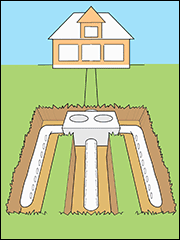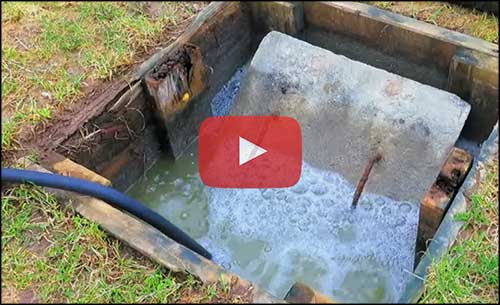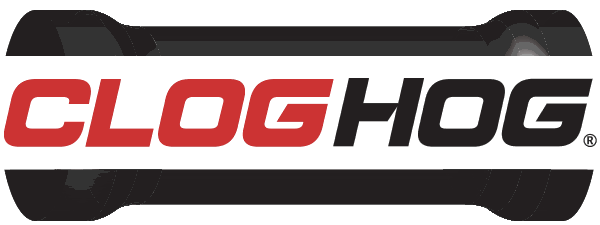Drain Cleaning Tips »
How Do I Unclog a Septic Leach Field?

It is often possible to clean and renew a clogged septic leach field instead of replacing the drain field lines.
Septic field lines can fail to drain when heavy solids accumulate and block perforations in the lines. This is commonly seen in septic systems that are more than 20 years old.
Note: when a septic system that's less than 20 years old fails to drain, it's sometimes a sign of tree roots clogging the lines, issues with the surrounding soil, structural damage to a pipe, or a faulty design.
- You can use a sewer jetter to clean perforated PVC septic leach field lines from 2" to 6" ID.
- If you're planning to clean only 3‑6" ID septic field lines, a competitor's lower-cost plastic-braided sewer jetter is a safer choice, since its longer bend radius reduces the risk of getting stuck in the larger perforations found in this type of pipe.
 For smaller septic field lines less than 3" ID, you can choose a Needle Nose™ drain cleaner with a tougher, braided steel jacket and a more compact nozzle tip that allows it to pass through more types and sizes of exterior and interior drains.
For smaller septic field lines less than 3" ID, you can choose a Needle Nose™ drain cleaner with a tougher, braided steel jacket and a more compact nozzle tip that allows it to pass through more types and sizes of exterior and interior drains.- A gas pressure washer rated 2.0 GPM to 4.0 GPM is usually required, since septic sludge can take significant force to scrub and flush out of the line. Regardless of their advertised ratings, electric pressure washers don't have sufficient power to scrub and flush the heavy sludge.
- It's usually recommended to locate and expose through digging the downhill end of each septic line, digging a large enough hole under each end for the sludge to flow out as you clean the opened line.
- If starting from an uphill opening or distribution box, the septic field lines must be allowed to drain or be pumped free of standing fluid, since nozzle jets produce almost no cleaning and flushing action when fully submerged in liquid.
 For more details you can watch this 3 minute video (part of Steve Maxwell's do‑it‑yourself Septic System Rescue video course).
For more details you can watch this 3 minute video (part of Steve Maxwell's do‑it‑yourself Septic System Rescue video course).- Note: a sewer jetter that's powered by your pressure washer can't clean septic field lines made of flexible hose less than 2" ID, or septic fields that consist of interlocking plastic chambers (sold as "Infiltrator" and others).
- Important: if you believe that there could be tree roots in the septic leach field lines:
- If there are many fine tree roots, you may be able to loosen the roots with a sewer jetter, and then pull out the long strings of roots by hand or by using a rented mechanical drum auger that has a root cutting blade.
- If there are larger tree roots in the line, you might need to start by using a rented mechanical drum auger with a root cutting blade to dislodge the roots, and then flush the line with a sewer jetter to remove the septic sludge.
- To clean the septic leach field with a sewer jetter:
 Put on fluid resistant work gloves and eye protection. Use extra care if you believe the drain might contain drain cleaning chemicals.
Put on fluid resistant work gloves and eye protection. Use extra care if you believe the drain might contain drain cleaning chemicals.- Connect the drain cleaner to your trigger gun, start the pressure washer, and then guide the nozzle at least a foot into the exposed septic field line opening before you start the flow of water.
- Guide the sewer jetter into the line as you squeeze the trigger. For more thorough cleaning, every few feet pull back about halfway and then continue moving forward.
- After you have finished cleaning the line, pull the drain cleaner out. Use care to release the trigger to stop the flow of water before the nozzle reaches the opening. Then replace any fittings, check the system, and restore the fill dirt.
- If you're not comfortable performing any of these steps, hiring a septic service company could save you money in the long run. To find a service company in your area:

- Start by asking family, friends and co-workers to recommend a company that has performed similar services for them.
- If you are unable to find a good recommendation from someone you know, search local directories like Google Maps, Yelp and CitySearch for service companies nearby who have good online reviews. Don't always trust reviews from individuals who published very few other reviews, or from people who give only positive reviews to everyone. Be aware that good service providers sometimes get a small number of negative reviews for reasons that might not be relevant to your situation. Look for a company with several reviews that tell a positive, believable story about repairs that are similar to yours.
- After you find one or more service companies that seem to have a good reputation, search online for the company name and the names of individuals at the company, if known. Take into account both the positive and negative information that you find about the company.
- Be aware that good service companies sometimes have a backlog of several days during peak times when there are low temperatures, heavy rainfall or holidays. Sometimes heavy demand can be a sign of a company with lots of repeat customers.
If you have questions or comments please contact us.






